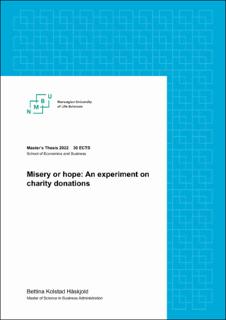| dc.contributor.advisor | Angelsen, Arild Einar Bjørn | |
| dc.contributor.author | Håskjold, Bettina Kolstad | |
| dc.date.accessioned | 2022-08-16T12:48:50Z | |
| dc.date.available | 2022-08-16T12:48:50Z | |
| dc.date.issued | 2022 | |
| dc.identifier.uri | https://hdl.handle.net/11250/3012142 | |
| dc.description.abstract | Aid organizations depend on private donations, hence they need to design fundraising campaigns which resonate with the viewer to trigger those donations. Research have found aid donations to often be fueled by a negative bias, meaning that fundraising campaigns should have a ‘tragedy’ framing to generate the most donations. This thesis tests experimentally if such a negative framing leads to higher donations than a positive framing. I also explore which demographic groups give more to charity.
An experiment using a real incentive probabilistic dictator game with a student sample recruited at the Norwegian University of Life Sciences is conducted to answer the main research question “Tragic or optimistic imagery, which better stimulates aid donations?”.
The subjects are presented with an aid project which is either negatively or positively framed and asked to answer a questionnaire where they allocate NOK 1000 between themselves and the project. The negative framed project has text and imagery which intend to provoke negative feelings within the reader, such as guilt and sadness. The positive framed project has positive imagery and text which intend to provoke positive feelings within the reader, such as hope and happiness.
The data analysis found no difference in donations towards the two projects, or any relationship between demographics and allocations to the presented project. This result can be backed up by previous studies, however I am careful with concluding as the design showed signs of being insufficient to properly answer the research question.
As for the sub-questions on which demographic groups give more to charity, three characteristics is found to have a significant effect on subjects’ donations: education, gender, and nationality. Both the simple t-tests and the regression analysis found both female and non-Norwegian students donated significantly more than their peers. A t-test also found significant differences between the attended faculty (education) groups.
The questionnaire invited respondents to provide a reasoning for their allocation, and 6 out of 10 that answered argued why they needed the money themselves, rather than reasons for giving.
The findings from this thesis suggest that a positive or negative framing of the fundraising material do not matter in terms of soliciting donations, and that the aid organization should rather focus on who they solicit, and their motivation for donating. | en_US |
| dc.language.iso | eng | en_US |
| dc.publisher | Norwegian University of Life Sciences, Ås | en_US |
| dc.rights | Attribution-NonCommercial-NoDerivatives 4.0 Internasjonal | * |
| dc.rights.uri | http://creativecommons.org/licenses/by-nc-nd/4.0/deed.no | * |
| dc.title | Misery or hope : an experiment on charity donations | en_US |
| dc.type | Master thesis | en_US |
| dc.description.localcode | M-ØA | en_US |

